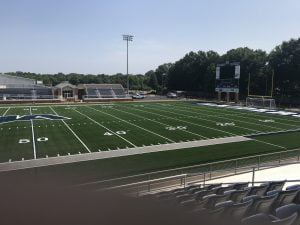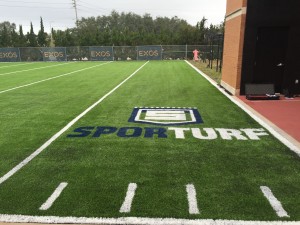Artificial Turf Football Fields on the Rise in New York
20 years ago, none of New York’s Section II high school football teams played on artificial turf. Fast forward to 2024 and more than 50% of New York’s Section II high schools have installed artificial turf football fields.
While the adoption of artificial turf by high schools varies by region, climate, and budget consideration, turf offers several benefits unique to the Northeast region of the US.
Weather Resilience
The Northeast experiences a range of weather conditions, including cold winters and wet springs. Artificial turf can withstand these conditions better than natural grass, which may become muddy and uneven after heavy rainfall or freeze during cold weather.
Year-Round Playability
Unlike natural grass, which may go dormant in the winter, artificial turf provides a consistent playing surface throughout the year. This is particularly beneficial for football programs that need reliable and safe playing conditions for practices and games.
Quick Drainage
Artificial turf systems often come with efficient drainage systems that prevent waterlogging. This is crucial in the Northeast, where heavy rains and snowmelt can saturate natural grass fields, leading to muddy and unsafe playing conditions.
Reduced Maintenance in Harsh Winters
Maintaining natural grass fields during harsh Northeast winters can be challenging and expensive. Artificial turf requires minimal maintenance in comparison, saving schools both time and money on snow removal, ice management, and other winter-specific field care.
Performance Consistency
The consistency of the playing surface on artificial turf is especially valuable in regions where natural grass may struggle to recover from winter dormancy. This ensures that football players have a reliable and predictable field surface for training and competitions.
Extended Playing Season
Artificial turf allows for an extended playing season. In the Northeast, where natural grass may take longer to recover in the spring, synthetic turf fields can be ready for use earlier, maximizing the opportunities for practices and games.
Resistance to Disease & Pests
Natural grass in the Northeast can be susceptible to various diseases and pests, especially during periods of high humidity. Artificial turf eliminates the need for pesticides and herbicides, providing a more environmentally friendly and resilient playing surface.
Community Access & Utilization
The ability to use artificial turf year-round makes it an attractive option for community events, youth sports, and other activities. This enhances the field’s value to the community and encourages more widespread use.
Sustainability
Some artificial turf systems are designed with sustainability in mind, incorporating recycled materials and reducing water consumption. This aligns with the growing emphasis on environmentally friendly practices and can be an essential factor for schools in the Northeast.
Economic Considerations
While the initial investment in artificial turf may be higher, the long-term cost savings in maintenance and the potential for increased community use and events can make it a financially sound decision for schools in the Northeast.

Considering the number of sports high schools offer these days, field use is at an all-time high. “In a given week, our primary field holds football games and practices, boys and girls varsity and junior varsity soccer games, field hockey games and practices, not to mention our band practices on the our field,” said one high school athletic director in New York. “And that’s just in the Fall!”
Artificial turf fields offer a perfect solution to address the growing demand on high school athletic fields.
With over 25 years worth of turf fields manufactured and installed, we know how to make the right product for you. Contact Sporturf if you are considering installing a turf field at your school sports complex. Check out some Sporturf’s turf field installations.
